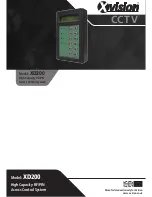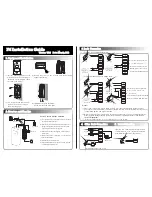Chapter 9 Interrupt Controller (INTC)
MPC5602P Microcontroller Reference Manual, Rev. 4
Freescale Semiconductor
219
9.6.2.1.3
Vector encoder subblock
The vector encoder subblock generates the unique 9-bit vector for the asserted interrupt request from the
request selector subblock for the associated processor.
9.6.2.1.4
Priority comparator subblock
The priority comparator submodule compares the highest priority output from the priority arbitrator submodule with PRI in
INTC_CPR. If the priority comparator submodule detects that this highest priority is higher than the current priority, then it asserts
the interrupt request to the processor. This interrupt request to the processor asserts whether this highest priority is raised above
the value of PRI in INTC_CPR or the PRI value in INTC_CPR is lowered below this highest priority. This highest priority then
becomes the new priority that will be written to PRI in INTC_CPR when the interrupt request to the processor is acknowledged.
Interrupt requests whose PRI
n
in INTC_PSR
n
are zero will not cause a preemption because their PRI
n
will not be higher than
PRI in INTC_CPR.
9.6.2.2
Last-in first-out (LIFO)
The LIFO stores the preempted PRI values from the INTC_CPR. Therefore, because these priorities are
stacked within the INTC, if interrupts need to be enabled during the ISR, at the beginning of the interrupt
exception handler the PRI value in the INTC_CPR does not need to be loaded from the INTC_CPR and
stored onto the context stack. Likewise at the end of the interrupt exception handler, the priority does not
need to be loaded from the context stack and stored into the INTC_CPR.
The PRI value in the INTC_CPR is pushed onto the LIFO when the INTC_IACKR is read in software
vector mode or the interrupt acknowledge signal from the processor is asserted in hardware vector mode.
The priority is popped into PRI in the INTC_CPR whenever the INTC_EOIR is written.
Although the INTC supports 16 priorities, an ISR executing with PRI in the INTC_CPR equal to 15 will
not be preempted. Therefore, the LIFO supports the stacking of 15 priorities. However, the LIFO is only
14 entries deep. An entry for a priority of 0 is not needed because of how pushing onto a full LIFO and
popping an empty LIFO are treated. If the LIFO is pushed 15 or more times than it is popped, the priorities
first pushed are overwritten. A priority of 0 would be an overwritten priority. However, the LIFO will pop
0s if it is popped more times than it is pushed. Therefore, although a priority of 0 was overwritten, it is
regenerated with the popping of an empty LIFO.
The LIFO is not memory mapped.
9.6.3
Handshaking with processor
9.6.3.1
Software vector mode handshaking
This section describes handshaking in software vector mode.
9.6.3.1.1
Acknowledging interrupt request to processor
A timing diagram of the interrupt request and acknowledge handshaking in software vector mode and the
handshake near the end of the interrupt exception handler, is shown in
the peripheral and software configurable interrupt requests. When it finds an asserted peripheral or
software configurable interrupt request with a higher priority than PRI in the associated INTC_CPR
,
it
asserts the interrupt request to the processor. The INTVEC field in the associated INTC_IACKR is


















